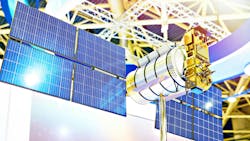Electrical Power Systems Meet the Density Demands of Small Satellites (Download)
Various power-generating system methods2 can be applied to space-based electrical power subsystems (EPS) to power spacecraft.
Such power sources include:
- Solar arrays: Photovoltaic modules can absorb sunlight in space, which generates DC electric power for satellites
- Lithium-ion batteries: These batteries are rechargeable (secondary) batteries. They’re used as energy storage devices and are mostly connected to, and charged by, a prime energy source, delivering their energy to the load on demand. Secondary batteries are also used in applications to provide power remotely from a separate power source that they return to periodically for recharge.
- Radioisotopes: A radioisotope power system (RPS) can generate power by converting the heat released from the nuclear decay of radioactive isotopes, like Plutonium-238 (Pu-238), into electricity.
- Fuel cells: Fuel cells are used for power and energy storage. Fuel cells will support DC electrical power buses:
- Multiple reactant types and grades (for example O2/H2 or O2/CH4)
- Enable Commercial Lunar Payload Services (CLPS) landers to use CH4 propellant for power
